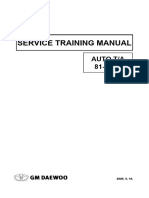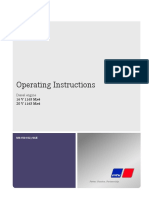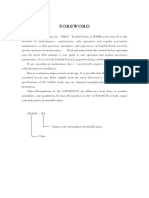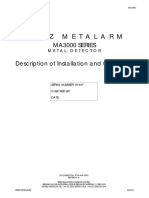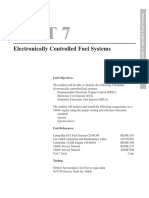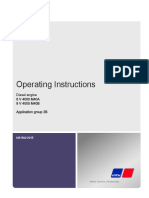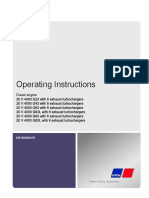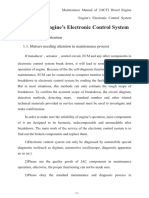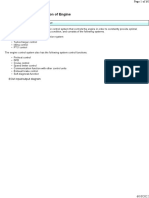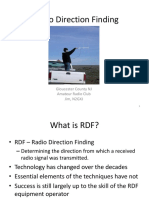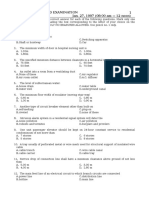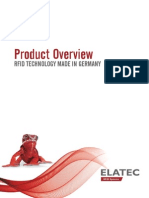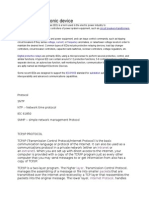1.5VCT Engine Management System and Engine Mechanical2
1.5VCT Engine Management System and Engine Mechanical2
Uploaded by
CARLOS OMAR ZARATE YATACOCopyright:
Available Formats
1.5VCT Engine Management System and Engine Mechanical2
1.5VCT Engine Management System and Engine Mechanical2
Uploaded by
CARLOS OMAR ZARATE YATACOCopyright
Available Formats
Share this document
Did you find this document useful?
Is this content inappropriate?
Copyright:
Available Formats
1.5VCT Engine Management System and Engine Mechanical2
1.5VCT Engine Management System and Engine Mechanical2
Uploaded by
CARLOS OMAR ZARATE YATACOCopyright:
Available Formats
版本信息- 2010 年 8 STENR3-0
月 内部资料 严禁外传
1.5VCT Engine Management System
Contents
Chapter 1 General Introduction 3
1.1 Engine Management System Components Location 4
1.2 Engine management system control diagram 5
1.3 ECM’s input signals and output signals 6
1.4 The description of function of ECM pins 8
Chapter 2 Fuel system 11
2.1 Fuel tank, Fuel pump and Fuel level sensors 11
2.2 Fuel injector 12
2.3 Fuel pump relay 14
2.4 Fuel system control 16
Chapter 3 Air intake system 21
3.1 Components introduction 21
3.2 Electronic Throttle Control ETC 30
3.3 Idle speed control 41
Chapter 4 Ignition System 47
4.1 Crank shaft position sensor and camshaft position sensor ( CKP and CMP ) 47
4.2 Ignition control 55
4.3 Knock control 58
Chapter 5 Exhaust system 61
5.1 Heated oxygen sensor ( HO2S ) 61
5.2 EVAP system ( EVAP ) 66
Chapter 6 starting and charging system 69
6.1 starting and charging control diagram(R750) 69
6.2 Starting system 69
1.5VCT Engine Management System
2 and Engine Mechanical
Chapter 7 1.5 L VCT System 71
7.1 General Introduction 71
7.2 VCT System Components 74
7.3 VCT Operations 86
7.4 Checking valve timing using oscilloscope 91
Additional : Engine management system wiring 92
diagram
Engine machinery
Chapter 8 1.5VCT engine mechanical and specification 99
8.1 1.5 VCT general introduction 99
8.2 Specifications 100
8.3 Engine component layout diagram 104
8.4 Main engine components introduction 110
8.5 Engine cooling system 114
Chapter 9 Disassemble and Fit Engine 117
9.1 The key steps of disassembling engine 117
9.2 Inspect and measure main components 130
9.3 The key steps of fitting procedures 136
1.5VCT Engine Management System
3 and Engine Mechanical
Chapter 1 General Introduction
NOTES
The 1.5 VCT Engine is fitted with Bosch ME7.9 engine management
system,
which is a sequential multi-point fuel injection system and is controlled
by Engine Control Module (ECM).
The ECM not only receives signals from sensor located in the engine ,
but also transmits signals through CAN bus.
The functions controlled by the ECM include:
• Fuel injection
• Ignition
• Electronic throttle
• EVAP
• VCT
• Heated Oxygen Sensor
• Fuel pump relay
• Cooling fan relay
• Main relay
• AC relay
1.5VCT Engine Management
4 System and Engine Mechanical
1.1 Engine Management System Components Location
NOTES
1. Engine coolant temperature sensor
2. Knock sensor
3. Oil pressure switch
4. Cam shaft position sensor
5. Heated oxygen sensor
6. Crank shaft position sensor
1.5VCT Engine Management
5 System and Engine Mechanical
1.2 Engine management system control diagram
NOTES
1 VCT control solenoid 12 Injector1~4
2 Oil temp sensor 13 HO2S
3 Cam shaft position sensor 14 Alternator
4 Electronic controlled throttle 15 Cooling fan relay unit
5 Brake switch 16 A/C pressure switch
6 TMAP 17 TCM
7 Ignition coil 1 、 2 18 ABS/EBD unit
8 Crank shaft position sensor 19 ECM
9 Knock sensor 20 BCM
10 Purge control valve 21 Instrument pack
11 Engine coolant temp sensor
1.5VCT Engine Management
6 System and Engine Mechanical
1.3 ECM’s input signals and output signals
NOTES
The table shows input and output signals from or to ECM transmitted
by special wires.
Input Out put
Ignition switch Cooling fan relay
Heated oxygen sensors A/C compressor relay
Throttle position sensors Main relay
Engine coolant temperature Fuel pump relay
Battery power Heated oxygen
TMAP/MAP Ignition coil
CMP Fuel injectors
CKP Electronic Controlled throttle
Load of generator EVAP
Oil temp sensor Oil control valve
Knock sensor Supply 5V to sensors
Break switch
A/C pressure 3-stage switch
Accelerate pedal position sensor
1.5VCT Engine Management
7 System and Engine Mechanical
The table shows input and output signals from or to ECM transmitted
NOTES
by CAN bus
Input Output
Immobilization Ignition switch position
Traction torque control Engine MIL status
Transmission MIL status Engine speed
Fuel tank level sensor Engine coolant temperature
Vehicle speed Gear selector lever position
Rough road signal TPS
Current gear APP
Gear changing in progress Torque reduction as gear
shifting
Transmission cooling request Traction torque control
1.5VCT Engine Management
8 System and Engine Mechanical
1.4 The description of function of ECM pins
NOTES
There is one connector of ECM, which is EM058.
The picture indicates the views of ECM terminals.
Pin NO Description
1 Upstream HO2S heated control
2 Ignition coil 2 control signal
3 Ignition grounded
4 Not used
5 Ignition coil 1 control signal
6 Injector 1
7 Injector 4
8 Not used
9 Not used
10 Not used
11 Not used
12 Battery power
13 Ignition power
14 From main relay
15 CKP sensor
16 APP1 signal
17 MAP ground
18 Upstream HO2S signal
19 Knock sensor terminal A
20 Knock sensor terminal B
1.5VCT Engine Management
9 System and Engine Mechanical
NOTES
Pin NO Description
21 Brake light switch
22 Not used
23 Not used
24 Not used
25 Not used
26 Not used
27 Injector 3
28 Down stream HO2S heated control
29 Not used
30 Not used
31 Not used
32 5V power supply2
33 5V power supply1
34 Not used
35 Sensor grounded 3
36 Sensor grounded 2
37 MAP signal
38 TPS2
39 signal
40 APP2
41 Not used
42 IAT signal
43 Not used
44 Power supplied by main relay
45 Power supplied by main relay
46 Purge valve
47 Injector 2
48 VCT control valve
49 Not used
50 Fan relay 1
1.5VCT Engine Management
10 System and Engine Mechanical
Pin No description NOTES
51 Ground
52 Not used
53 Ground
54 TPS 1
55 Downstream HO2S signal
56 Oil temp sensor signal
57 Not used
58 Brake switch
59 Alternator load signal
60 AC middle pressure switch
61 Ground
62 CAN H
63 Power supplied by main relay
64 Throttle motor +
65 Throttle motor +
66 Throttle motor -
67 Throttle motor -
68 Fan relay 2
69 AC compressor relay
70 Fuel pump relay
71 Diagnostic K bus
72 Not used
73 IMMO code
74 Clutch switch
75 AC request signal
76 Not used
77 Not used
78 Ground
79 Cam shaft position sensor
80 Ground
81 CAN L
1.5VCT Engine Management
11 System and Engine Mechanical
Chapter2 Fuel system
NOTES
2.1 Fuel tank, Fuel pump and Fuel level sensors
Components introduction in the fuel tank :
Fuel pump and regulator are located in the middle of fuel tank;
Filter is in the outside of the fuel tank;
There is a fuel level sensor inside the fuel tank , which signal sends to IPK.
Fuel pump supplies fuel to engine with pressure.
1.5VCT Engine Management
12 System and Engine Mechanical
2.2 Fuel injector
NOTES
1.8L VCT engine has four fuel injectors, which are controlled by the ECM
in the sequence of 1.3.4.2. The fuel injectors supply regulated quantity of
fuel to the engine and ensure fuel has a good effect of atomization.
Feature :
The injectors are sealed to the fuel rail with single 'O' ring and at the
manifold with single 'O' rings. The injector consists of a pintle type
needle and seat and a solenoid winding which lifts the needle against a
return spring. Fuel ejects from two nozzles into the manifold and cylinder
head intake tracts.
The injector delivers fuel once per engine cycle, each injector opening
during the intake stroke. The solenoid winding has a resistance of 13 -
16Ω at 20°C. The fuel injectors operate at a regulated pressure of 3.8
bar . This pressure is controlled by a regulator incorporated into the fuel
tank.
1.5VCT Engine Management
13 System and Engine Mechanical
The feature of control signal : NOTES
The power is supplied by the main relay when ignition switch is in “on”
position. The next picture shows the waves of control signal measured in
the vehicle.
As shown, it is a complete wave form, in which high voltage (14v)
means that the injector is not running, low voltage (0v) between the two
time ruler is the duration of the injector.
The high voltage in the diamonds is induced by the coil as the current
is cut down.
Failure feature :
The ECM can monitor the controlling wire path and record the duration
of injectors. If there is a problem, ECM can store the faulty code :
1.5VCT Engine Management
14 System and Engine Mechanical
The fuel injector can fail in the
following ways:
• Injector open circuit
•
NOTES
Short circuit to 12V
• Short circuit to earth
• Intermittent injector open circuit
• Blocked injector
• Blocked air cleaner element
• Split or cracked intake air shrouds
• Injector stuck open
In the event of fuel injector signal failure any of the following symptoms
may be observed:
• Rough running
• Difficult starting
• Engine misfire
• Possible catalyst damage
2.3 Fuel pump relay
Location :
Fuel pump relay is located in the fuse box in the engine compartment.
As shown, R8 is fuel pump relay.
1.5VCT Engine Management
15 System and Engine Mechanical
Function :
NOTES
1 . Ignition off(0)
2 . Ignition (II)
3 . Ignition in crank position (III) and engine is running 。
As shown, fuel pump relay will operate in the following two conditions :
• The relay will be engaged to build primary pressure for nearly two
seconds after ignition switch is turned to “on” position.
• When the ECM receives CKP signal which means the engine is
running the fuel pump relay will be engaged.
Signal analyse :
• 30 battery power through inertia switch
• 87 power supplied to fuel pump
• 85 power is supplied by main relay
• 86 Controlled by the ECM, ECM will engage an earth path when
engine is running or for two seconds after the ignition switch is
turned to the “on” position.
1.5VCT Engine Management
16 System and Engine Mechanical
Failure modes
If the fuel pump relay fails whilst driving the engine will lose power and NOTES
eventually cut out due to fuel starvation. The fuel pump relay could fail in
the following ways:
• Relay coil short circuit
• Relay coil open circuit
• Relay coil high resistance
• Relay contact stuck open
• Relay contact stuck closed
• Relay contact high resistance
• Relay wiring open circuit
• Relay wiring high resistance
• Relay wiring short circuit to 12 volts
• Relay wiring short circuit to earth
• ECM not providing earth path
If the fuel pump relay fails the following symptoms will be observed:
At start up
If the fuel system pressure has fallen to zero the engine will not fire.
If the fuel system pressure has fallen below normal operating pressure
(3.8 bar) the engine may attempt to fire but will not run normally.
If the fuel system pressure is normal the engine will fire and run but will
eventually cut out as the fuel pressure falls, it will not be possible to
restart it.
During driving
If the fuel pump relay fails whilst driving, the engine will lose power and
eventually cut out due to fuel starvation.
2.4 Fuel system control
Fuel quantity
The ECM controls fuel quantity by providing sequential injection to the
cylinder head intake ports. Sequential injection allows each injector to
deliver a precise amount of fuel to the cylinder intake ports, during the
induction stroke, in cylinder firing order. The CMP sensor allows the
ECM to synchronize injection at cranking speed for starting. The
precise quantity of fuel delivered is controlled by adjusting the duration
of the injector open time. To achieve optimum performance the ECM is
able to 'learn' the individual characteristics of a vehicle and adapt the
fuelling strategy to suit. This capability is known as adaptive fuel
strategy. To achieve optimum fuel quantity under all driving conditions
the ECM must provide an adaptive fuel strategy. Adaptive fuel strategy
is maintained under all conditions except:
1.5VCT Engine Management
17 System and Engine Mechanical
• Cold starting
• Hot starting
NOTES
• Wide open throttle
All of the above conditions are deemed to be 'open loop'. Open loop
fuelling does not rely on information from the HO2S, but sets the
Air/Fuel Ratio (AFR) according to the stored data in the ECM. During
cold starting and running, the ECM references the ECT to calculate the
appropriate amount of fuel required to support combustion and adjusts
the idle speed to the correct 'fast idle' value. This strategy is maintained
until the HO2S is hot enough to provide an accurate feedback signal.
The specific nature of the other listed open loop conditions means that
the HO2S feedback is unsuitable as a control value for fuelling.
Adaptive strategy also allows the ECM to compensate for wear in
engine components and to compensate for production tolerance
variation in mass produced components such as sensors.
Function
To calculate the amount of fuel to be injected into each cylinder the
ECM has to determine the quantity of oxygen available in the cylinder
to burn it. This can be calculated by processing information from the
following sensors:
• IAT/MAP sensor / TAMP sensor
• CKP sensor
• ECT sensor
• Electronic controlled throttle
During one engine revolution 2 of the 4 cylinders (1.8T)draw in air. The
ECM uses the CKP sensor signal to determine the potential air intake
volume in the cylinders. The oxygen content of the air contained in the
cylinders can be calculated by the ECM using information from the
TMAP sensor or the IAT/MAP sensor. The pressure of the air in the
intake manifold will vary according to the following factors:
• The position of the throttle valve (driver input)
• The atmospheric pressure (altitude and weather conditions)
• The mechanical condition of the engine (volumetric efficiency)
The pressure in the intake manifold, positions of the accelerator pedal,
indicate how much air has flowed into the cylinders. This will decrease
at higher altitudes as the air becomes 'thinner' or less dense.
This will also mean that there will be less oxygen contained in the air
which will be available for combustion of fuel. The temperature of the
air will also affect the oxygen content. Air which is cool has molecules
packed closer together than hot air, therefore cooler air contains more
oxygen for any given volume than hotter air.
1.5VCT Engine Management
18 System and Engine Mechanical
From the above information, the ECM can calculate how much air has
been induced into the cylinders. The oxygen content is determined by NOTES
adding the IAT into the equation. By comparing these values to a
fuelling map stored in the ECM memory, the amount of oxygen induced
into the cylinders can be calculated. The values obtained from the ECT,
engine oil temperature and electronic controlled throttle provide 'fine
tuning' to the calculations. To deliver fuel to the engine the ECM
completes an earth path to the injector winding, opening the injector for
the precise amount of time required for the quantity determined. The
correct cylinder order is determined by referencing the CMP sensor
during start up to synchronise the camshaft signal to the crankshaft
signal. The fuel is injected into the inlet ports of the intake manifold and
is drawn into the cylinder as an air and fuel mixture. The ECM also
uses the TMAP or IAT/MAP sensor signal to compensate for the effects
of varying pressure differential around the injector outlets. The ECM
corrects the injector duration time, using TMAP or IAT/MAP sensor
information, so that a conventional fuel rail mounted pressure regulator
and return line are unnecessary. The ECM references battery voltage
to adjust opening times to suit the state of battery charge. This is
required because low battery voltage will mean slower response from
the injectors and could give a leaner AFR than intended.
Closed loop fuelling
The ECM uses a closed loop fuelling control system as part of the
overall strategy. The efficient operation of the three way catalytic
converter relies on the ECM switching the AFR from rich to lean within
the lambda window. The lambda window is 1.00 ± 0.03. In petrol
engines, an AFR of 14.7: 1 (by weight) corresponds with a lambda
value of 1.00. When the AFR ratio becomes richer the lambda value
reduces, e.g. 0.97 is richer than 1.00. When the AFR ratio becomes
leaner the lambda value increases, e.g. 1.03 is leaner than 1.00.To
achieve closed loop fuelling the ECM interacts with the following
components:
• HO2S (upstream of catalyst)
• Fuel injectors
Closed loop fuelling is a rolling process controlled by the ECM. The
ECM uses information from the CKP, ECT, TMAP (or IAT/MAP), and
electronic controlled throttle, together with a signal for road speed from
the ABS ECU, to calculate the amount of fuel required to achieve an
AFR within the lambda window during the following conditions:
• Idle
• Light engine load
• Cruise
1.5VCT Engine Management
19 System and Engine Mechanical
Function
When the engine is operating in the above conditions the ECM
NOTES
implements the closed loop fuelling strategy. The amount of residual
oxygen remaining in the exhaust gas can be used as an indicator of
air/fuel ratio. The HO2S produces an electrical voltage signal
proportional to the amount of oxygen present in the exhaust gas
(passing over the tip of the sensor) in comparison with the ambient air.
The ECM can process the voltage obtained by the sensor and
extrapolate the corresponding air/fuel ratio. When the ECM receives a
voltage signal corresponding with an AFR at the lean limit of the
lambda window the amount of fuel delivered is increased. When the
rich limit is reached the fuel is reduced until the lean limit is reached. It
can be seen that the process is a continuous switching from rich to
lean within the constraints of the lambda window which allows the
catalyst to absorb and release oxygen for optimum efficiency. Note that
the HO2S sensor will only give a reliable reading when it has achieved
a temperature of approximately 300°C (572°F).
Open loop fuelling
The ECM uses open loop fuelling when it is not possible, or desirable,
to use feedback from the HO2S to control the AFR. In those
circumstances the ECM must use information from the other sensors
and look up tables stored in memory to set fuelling parameters.
Conditions
The open loop fuelling strategy is used in the following conditions:
• Cold start
• Warm up (until HO2S is functional)
• Full load.
• Part throttle acceleration (beyond 85° throttle opening)
1.5VCT Engine Management
20 System and Engine Mechanical
• Hot start (until HO2S is functional)
• Overrun fuel cut off NOTES
• HO2S failure
Function
During cold starting the engine temperature is low enough to promote
fuel condensation on the cold surfaces of the inlet manifold and
cylinder walls. This will leave the AFR lean and poorly distributed
through the charge to provide a readily combustible mixture. To
overcome this problem the ECM must increase the amount of fuel
injected and thereby provide a rich AFR. The primary input for this
stage is from the ECT sensor, which is used to provide a reference for
the look up tables for cold start fuelling. Once the engine has fired the
ECM will reference the ECT, TMAP (or IAT/MAP), electronic control
throttle and CMP sensors to modify the fuelling as the engine warms
up. As the engine temperature rises, the AFR can be leaned off until the
HO2S are functional and the ECM can monitor the residual oxygen
content. The AFR required for maximum power (12:1) is richer than that
required for maximum catalyst efficiency (14.7:1).Therefore when the
engine is required to produce more power by sudden application of the
throttle or continuous full throttle operation, the ECM must allow the
AFR to override the lambda window control. When a hot engine is
turned off, fuel in the injectors and injector rail absorb heat, this causes
the characteristics of this fuel to change. A hot start becomes more
demanding due to difficulties in achieving the correct AFR and even
mixture distribution. To overcome these problems the ECM references
the ECT sensor and enriches the AFR to aid starting. When the vehicle
is decelerating with the throttle closed, the fuel injection can be
completely switched off. During this phase the ECM looks at the
following inputs to determine whether overrun fuel cut off should be
enabled:
• CKP (engine speed)
• Electronic control throttle (throttle position)
• ABS ECU (vehicle speed)
• ECT (engine coolant temperature)
In overrun fuel cut off the HO2S output is ignored by the ECM. If the
output from the HO2S is missing, or outside the ECM tolerances, the
open loop fuelling strategy will be implemented.
1.5VCT Engine Management
21 System and Engine Mechanical
Chapter 3 Air intake system
NOTES
3.1 Components introduction
Engine coolant Temperature sensor ECT
Location
The ECT is amounted to outlet pipe in the cylinder head.
ECT function
The ECM uses ECT signal to
• Vary air/fuel mixture (a richer mixture when engine is cold)
• Control cooling fan relay
• Calculate fuelling time and ignition timing parameters during start up
• Determine idle speed
• Transmit the ECT message to IPK Via the CAN-bus
• Engage EVAP solenoid
• Engage AC compressor clutch relay
• Determine the timing entering the closed loop
1.5VCT Engine Management
22 System and Engine Mechanical
ECT feature and structure
The ECT sensor consists of an encapsulated
NOTES
Negative Temperature Coefficient (NTC)
thermistor which is in contact with the engine
coolant. The ECT sensor is part of a voltage
divider circuit which consists of a regulated 5 volt
supply and a fixed resistor (both inside the ECM)
and a temperature dependent variable resistor
(the ECT). The properties of the NTC thermistor
are such that as the temperature of the coolant
increases, the resistance through the ECT
reduces. This produces a fall in signal voltage as
more current passes through the ECT and to
earth via the ECM.
ECT signal analyse
EM015-1 grounded by the internal
EM015-2 signal supplies to the ECM
The next picture shows the signal voltage from ECM after the
connector is cut when the ignition switch is in “on” position.
The 5V power is supplied by the ECM
1.5VCT Engine Management
23 System and Engine Mechanical
The next picture shows the signal voltage measured in the terminal
C0169A-2 when engine runs in normal temperature:
NOTES
The picture indicates the signal voltage is about 0.5V
The voltage is varied between 0V to 5V. Higher temperature, lower voltage.
Failure modes
The ECT sensor can fail, or provide the incorrect signal in the following
ways:
• ECM not provide earth path
• ECT thermister element damaged or destroyed
• Incorrect mechanical installation
In the event of an ECT sensor signal failure any of the following
symptoms may be observed:
• Difficult cold start
• Difficult hot start
• Poor drive ability
If sensor output is short circuit to 12 or 5 volts the engine will run with a
default value Engine will not start if sensor earth is short circuit to 12 or 5
volts
• Temperature gauge reads excessively hot
• Temperature gauge reads excessively cold
• Cooling fan may operate continuously at fast speed
• High temperature warning lamp may flash whilst gauge is indicating
cold
1.5VCT Engine Management
24 System and Engine Mechanical
Inlet air temperature and manifold absolute pressure sensor
NOTES
Location
1.5 VCT engine has one manifold absolute pressure sensors, which is
mounted behind the throttle at the end of manifold. The name is called
TMAP because it integrates IAT ( Inlet air temperature ) .
Inlet Air Temperature sensor ( IAT )
IAT negative temperature
coefficient resistance
The IAT is integrated into TMAP which is located behind the throttle body.
1.5VCT Engine Management
25 System and Engine Mechanical
IAT function
The IAT sensor provides a signal which enables the ECM to adjust ignition NOTES
timing and fuelling quantity according to the intake air temperature, thus
ensuring optimum performance, drivability and low emissions.
IAT operation feature
The IAT sensor is a negative temperature coefficient (NTC) sensor. As the
temperature rises the resistance of the sensor decreases. As temperature
decreases, the resistance in the sensor increases. The change in
resistance is proportional to the temperature of intake
air. From the voltage of the sensor, the ECM calculates the temperature of
ambient air. If the air temperature rises above 55°C (169°F) the
ECM retards the ignition timing to prevent pre-ignition. If the IAT sensor
fails or is disconnected, the vehicle will still run. The ECM will substitute a
default value reflecting a temperature of 45°C (113°F). The ECM
uses the information from the speed/load map to run the engine, but
adaptive fuelling is disabled. This condition would not be immediately
apparent to the driver, but the ECM will store fault codes which can be
retrieved using T5.
1.5VCT Engine Management
26 System and Engine Mechanical
IAT signal feature
NOTES
The signal voltage (2.9v) is measured when the ambient air temperature is
at about 10℃. The voltage decreases as air temperature increases.
The next picture indicates the relations among voltage, resistance and
temperature :
IAT Signal
Temperature (°C) resistance (Ω) output signal (V)
0 5805.4 3.72
20 2498.9 2.78
50 837.2 1.48
75 382.6 0.8
100 192.6 0.44
1.5VCT Engine Management
27 System and Engine Mechanical
Manifold absolute pressure sensor ( TMAP , behind the throttle
body ) NOTES
TMAP location
TMAP is located on the intake hose behind the throttle body.
TMAP function
ECM uses TMAP signal to calculate the amount of air induced into the
cylinders. The main functions are :
• To determine the ignition timing and fuel injection duration values.
• To monitor the atmosphere pressures
• To identify the engine load
TMAP signal feature
EM010-B the signal of IAT, which voltage varies with the changing of IAT
EM010-A the common earth of IAT and MAP
1.5VCT Engine Management
28 System and Engine Mechanical
EM010-D MAP signal, the voltage varies with the changing of pressure
NOTES
EM010-C ECM supplies 5V power to MAP
The next picture indicates the signal voltage of MAP as Engine is not
running but ignition switch is in “on” position.
The voltage value is about 2V as the pressure is at standard atmosphere.
The next indicates signal voltage as idling :
The value is about 1.59 V
1.5VCT Engine Management
29 System and Engine Mechanical
Failure modes
The TMAP sensor can fail or provide the incorrect signal in the following NOTES
ways:
• Air pressure not communicated to TMAP sensor (mechanical
blockage or leak)
• External wiring open circuit
• External wiring short circuit to earth
• External wiring short circuit to 5V
• ECM not providing 5V supply
• ECM not providing earth path
• TMAP sensor output not to specification.
• Increased sensor resistance
• Damaged sensor element
In the event of an TMAP sensor signal failure any of the following
symptoms may be observed:
• Vehicle difficult to start, stalls at idle or misfires
• Lack of power especially in high ambient temperatures
• ECM reverts to a default setting
1.5VCT Engine Management
30 System and Engine Mechanical
3.2 Electronic Throttle Control ETC
NOTES
The ETC system is controlled by the ECM, which includes the throttle
body and accelerate pedal position sensor
1. Accelerator pedal module
2. ECM
3. TPS
4. Motor
5. The throttle valve
Accelerator pedal position sensor ( APP )
APP location
Located on the driver side and connected mechanically with accelerator
pedal.
1.5VCT Engine Management
31 System and Engine Mechanical
APP function
NOTES
The APP is a very important input signal in the ETC system. ECM uses
the signal to know the driver’s request and to control the motor in the
throttle body.
APP construction
It has two potentiometer position sensors.
APP principle
APP ECM
5V reference
APP1 APP1 signal
earth
5V reference
APP2 APP2 signal
earth
Each sensor has three pins :
• 5V reference
• earth
• signal
1.5VCT Engine Management
32 System and Engine Mechanical
APP signal analyse
NOTES
Earth APP1signal 5Vpower earth APP2 signal 5Vpower
BD019-4 is APP1 signal , which value increases by the increment
of pedal travel.
BD019-6 is APP2 signal , which is equal to a half of APP1.
1.5VCT Engine Management
33 System and Engine Mechanical
The next shows the signal values of APP1 and APP2 as the pedal
at 0% position. NOTES
The value of blue line (up) is about 0.78V (APP1)
The value of red line ( below) is about 0.39V(APP2)
The next shows the signal values of APP1 and APP2 as accelerating and
decelerating.
It is apparent that APP1 is equal to two times of APP2 at any pedal
position.
1.5VCT Engine Management
34 System and Engine Mechanical
The next indicates the signal values of APP1 and APP2 as the pedal at
100% position NOTES
The value of blue line ( up ) is about 4.0V (APP1)
The value of red line (below) is about 2.0V (APP2)
The values of APP1 and APP2 at the whole pedal travel.
APP1 0.78V~4.0V
APP2 0.39V~2.0V
1.5VCT Engine Management
35 System and Engine Mechanical
Electronic throttle control body. ( ETC )
NOTES
ETC location
ETC body is located in the intake hose
ETC function
The electronic controlled throttle which executes the instruction from
engine ECU to adjust throttle opening angle is the key component in the
system to control engine output. Meanwhile, it can output TPS feedback
signal to management system for monitoring throttle operation.
1.5VCT Engine Management
36 System and Engine Mechanical
ETC construction
NOTES
Electronic Throttle Body consists of throttle body, stepper motor and
throttle position sensors. The ECM controls the stepper motor’s action to
ensure the required throttle opening through the drive mechanism.
ETC operation principle
Direct current motor spins with certain angle to open the throttle with
certain angle by driving mechanism for controlling the intake air volume.
Meanwhile, the potentiometer’s movement driven by throttle cause the
potentiometer’s output signal variation. Engine ECU can identify the
throttle opening angle basing on signal. The potentiometer consists of two
opposite polarity meters one indicates positive opening position and the
other indicates negative opening position. ECU can check the throttle
operation by comparing the two opposite signal.
ETC signal analyse
5V ground motor+ motor- TPS1 signal TPS2 signal
EM004-1 and EM004-4 are to drive motor
EM004-6 is TPS1 signal, EM004-5 is TPS2 signal
1.5VCT Engine Management
37 System and Engine Mechanical
TPS signal measuring NOTES
The signal value of TPS1 when ignition switch is in “on” position
The value is about 0.77V when the ETC is free
The signal value of TPS2 when ignition switch is in “on” position
The value is about 4.23V when the ETC is free
1.5VCT Engine Management
38 System and Engine Mechanical
The two values of TPS1and TPS2 when the ignition switch is in “on”
position and engine is not running. NOTES
The sum of TPS1 and TPS2 is about 5V
The relation between TPS1 and TPS2
TPS1 value increase as the increment of opening angle
TPS2 value decrease as the decrease of opening angle
The sum of TPS1 and TPS2 is about 5V at any opening position.
1.5VCT Engine Management
39 System and Engine Mechanical
NOTES
The TPS1 and TPS 2 signals as accelerating and decelerating.
Measuring the motor control signal
The next shows Pin1 and Pin4 signals with PCO using two channels :
Pin1 : red line ( up ), battery
Pin4 : blue line ( below ), a varying PWM signal
The current direction is from Pin1 to Pin4
1.5VCT Engine Management
40 System and Engine Mechanical
The signals measured in a certain opening angle of the ETC
NOTES
Pin1 : the value of red line ( below ) is 0V , grounded
Pin4 : the value of blue line ( up ) is a PWM signal
The current direction is from Pin4 to Pin1
1.5VCT Engine Management
41 System and Engine Mechanical
3.3 Idle speed control
NOTES
The ECM controls engine idle speed. The ECM uses two methods of idle
speed control:
• Ignition timing adjustment.
• Electronic controlled throttle.
When the engine idle speed fluctuates, and there are no additional loads
on the engine, the ECM will vary the ignition timing to control the idle
speed. This allows very rapid correction of out of tolerance idle speeds.
When an additional load is placed on the engine, such as when the power
steering is turned, the ECM uses a combination of electronic controlled
throttle and ignition timing to increase the idle speed to specification.
The idle speed is determined from the CKP sensor, and information from
the other engine management sensors, but there are also inputs to the
ECM from the following:
• Alternator load
• A/C system
• Cooling fan status
If the ECM receives information from the above inputs that an extra load
is being placed on the engine it can immediately compensate and avoid
an engine stall condition.
1.5VCT Engine Management
42 System and Engine Mechanical
Alternator load signal
NOTES
Signal function
The alternator load signal is provided by the regulator in the alternator
and is sent to the ECM which adjusts the idle speed under varying
electrical loads
Signal feature
The signal is PWM ( pulse width modulated ) signal, in which the rate of
low voltage in a cycle reflects the load of generator. The bigger rate, the
greater load.
1.5VCT Engine Management
43 System and Engine Mechanical
NOTES
The next shows the voltage of EM025-3 when ignition switch is “ON”
and the connector is disconnected.
ECM outputs a signal voltage of 10.8V to detect the current
Measuring the signal when Engine is at idle with much load of electricity
T1
As shown, T1/T reflects the load of generator. The value of T1/T is bigger,
the load of generator is greater.
1.5VCT Engine Management
44 System and Engine Mechanical
Measuring the signal when engine is accelerating
NOTES
T1
Comparison with when engine at idle, the value of T1/T is reduced. It is
caused by higher speed of generator, which can increase the generating
capacity
Signal influence
The signal sent to ECM can affect on the stability of idling. But it can not
affect on the generating of alternator even if the signal wire is
disconnected.
1.5VCT Engine Management
45 System and Engine Mechanical
Air conditioning pressure switch ( ACP )
NOTES
ACP switch is located in the high pressure line in front of right firewall.
Function
The ACP sensor detects the refrigerant pressure and sends the signal to
ECM, which uses it to control:
• Compressor clutch relay
• Cooling fan relay
ACP signal feature
EB014-1 : To ECM
EB014-2 : To ECM
EB014-3 : ground
EB014-4 : From AC panel
1.5VCT Engine Management
46 System and Engine Mechanical
NOTES
Terminal function :
EB014-1 and EB014-4 for high-low pressure switch
EB014-2 and EB014-3 for medium pressure switch
The contact between EB014-1 and EB014-4 is connected as pressure is
normal and disconnected as pressure is too low or too high.
The contact between EB014-2 and EB014-3 is disconnected as pressure
is below17.7Bar.
The failure of ACP may cause:
• The compressor will not run
• Abnormal operation of cooling fan.
1.5VCT Engine Management
47 System and Engine Mechanical
Chapter 4 Ignition System
NOTES
4.1 Crank shaft position sensor and camshaft position
sensor ( CKP and CMP )
CKP location
The CKP sensor is mounted on the rear face of the cylinder block
CKP function
• Calculate the rotating speed of crank shaft
• Determine the position of crank shaft
• Supply the signal to ECM to control ignition timing and fuel injection
timing
• Misfire detecting
CKP construction
The CKP sensor is a hall effect sensor to detect a reluctor mounted on
the crank shaft. The teeth on the reluctor ring are spaced at 60 intervals.
There are 58 teeth, this leaves a space where two teeth are missing. The
ECM detect the missing teeth to identify the position of crank shaft.
1.5VCT Engine Management
48 System and Engine Mechanical
CKP signal feature
NOTES
From
CKP signal ground main relay
12V
CKP EM012-2 is the signal of CKP, which is a digital square wave
with high voltage of 5V.
The next is the CKP waveform when the engine runs at idle speed.
The wider square wave happens at the missing teeth.
The time difference between two wider wave represents the period during
the crank shaft rotates one cycle.
1.5VCT Engine Management
49 System and Engine Mechanical
Failure modes
NOTES
It is vital that the correct air gap is maintained. If the air gap becomes too
wide, the CKP signal becomes too weak causing possible engine misfires
to occur. The CKP sensor can fail, or supply an incorrect signal, in the
following ways:
• CKP sensor hall effect semiconductor destroyed
• CKP magnetic field too weak
• CKP sensor wiring open circuit
• CKP sensor wiring short circuit
• CKP sensor wiring high resistance
• Reluctor contaminated with dirt
• Reluctor definition poor due to corrosion or mechanical
• CKP signal distorted due to flywheel or drive plate runout
• CKP signal variation due to crank radial movement
• ECM cannot achieve synchronisation of crank to software program
due to wrong pattern of missing teeth on target.
• Incorrect fitting and integrity of the sensor
• Water ingress
In the event of a CKP sensor signal failure any of the following symptoms
may be observed:
• Engine cranks but fails to start
• MIL illuminated
• Engine misfires (CKP sensor incorrectly installed)
• Tachometer inoperative
• Engine runs roughly or stalls (CKP sensor incorrectly fitted)
• Engine fails to rev over 2000 rev/min and fails to restart after
switching off (CKP signal lost during engine running)
1.5VCT Engine Management
50 System and Engine Mechanical
Camshaft Position Sensor CMP location
NOTES
CMP sensor is fitted in the cylinder head and on the side of inlet camshaft
CMP function
ECM uses the CMP signal to determine the camshaft position, and then to
control sequential fuel injection and ignition timing. It is a necessary signal
to control variable intake camshaft.
CMP construction
CMP is a Hall effect device, which detects 4 targets mounted in
the relucator.
1.5VCT Engine Management
51 System and Engine Mechanical
CMP signal
NOTES
Power Signal Ground
CMP EM007-2 is a signal of CMP, which is a digital square
wave with high voltage 12V. We can measure it as followings.
1. Dismantle the CMP sensor from the camshaft cover, maintain
connecting pin of CMP sensor then turn the ignition switch to the
“ON” position. Measure the signal when there is nothing on the
head of the sensor.
The value of 12V can be observed
1.5VCT Engine Management
52 System and Engine Mechanical
2. As the next picture shown, place an iron material like a screwdriver
near the head of sensor. NOTES
Then observe the signal voltage.
The value is 0V.
1.5VCT Engine Management
53 System and Engine Mechanical
3. And then install the sensor, start the engine observe the NOTES
waveform.
We can observe a digital square wave oscillating between 0V and 12V
CMP may cause:
• The engine is not easy to start.
• The engine may die occasionally
• The ECM will not detect the misfire of the cylinder.
1.5VCT Engine Management
54 System and Engine Mechanical
Measure the CKP and CMP signals with two channels using PCO
NOTES
The next picture is a waveform which has two synchronous signals.
• The waveform can identify the relative positions between the crank
shaft and camshaft.
• The red wave is CKP signal, the blue wave is CMP signal.
• When the valve timing of the engine is correct, there is a certain wave
number of CKP between ruler A and ruler B.
1.5VCT Engine Management
55 System and Engine Mechanical
4.2 Ignition control
NOTES
Two ignition coils are mounted on the camshaft cover above the spark
plugs for cylinders 1 and 3 and secured with screws. Each coil operates a
pair of spark plugs using the wasted spark principle. The coil has a plug
connection on its lower face and a lead which connects to the second
plug. The coil fitted above cylinder 1 is attached to the spark plug for
cylinder 1 and the lead connects to the spark plug for cylinder 4. The coil
fitted above cylinder 3 is attached to the spark plug for cylinder 3 and the
lead connects to the spark plug for cylinder2.
The ignition timing is an important part of the ECM adaptive strategy. The
timing of the spark will affect the quality of combustion and the power
produced. The ECM will reference all relevant sensors to achieve the
optimum timing for any given condition. The duration of the ignition spark
depends on the time allowed for the current to flow through the primary
coil windings (the dwell period). At high engine speeds the dwell period is
shorter and a reduced spark duration can result. Constant energy
systems overcome this by electronically increasing the dwell period and
engine speeds rise thus maintaining a strong ignition spark at all engine
speeds. The ECM calculates ignition timing using inputs from the
following:
• CKP sensor
• TMAP sensor
• TP sensor
• ECT sensor
1.5VCT Engine Management
56 System and Engine Mechanical
Signal analyse
NOTES
Power supplied by main relay
Measure the control signal when the engine is running :
Note: it is necessary to connect the attenuator when measuring the
voltage of the primary coil.
1.5VCT Engine Management
57 System and Engine Mechanical
The next shows the secondary voltage
NOTES
As shown, the waveform with a high voltage reflects the cylinder is in
the end of the compressor stroke, and the waveforms with low
voltage reflect the cylinders are in the end of exhaust stroke.
1.5VCT Engine Management
58 System and Engine Mechanical
4.3 Knock control
NOTES
Knock sensor ( KS )
Location
The knock sensor is fitted to the rear of cylinder block near cylinder 2
Function
The knock sensor is used to detect knock or “ detonation” which occurs
.ECM uses the signal to modify advanced ignition timing to avoid knock
or “ detonation”.
Construction
1.5VCT Engine Management
59 System and Engine Mechanical
Installing torque
NOTES
The torque is 25Nm
Signal feature
The knock sensor creates an AC voltage, which value increases as
vibration enhances.
The next picture shows the signal of knock sensor as engine is
running.
1.5VCT Engine Management
60 System and Engine Mechanical
Knock control
NOTES
The knock sensor signal is processed by the ECM which will retard the
ignition timing by 3°. If this resolves the problem then the ECM will restore
the ignition timing to its original value in increments of 0.75°. If the knock
persists, the ECM will retard the ignition by a further 3° up to -15°. When
the knock has been resolved, the ECM will restore the ignition timing to its
original value in increments of 0.75°.
The knock sensors can fail, or provide an incorrect signal, in the
following ways:
• Sensor open circuit
• Short circuit to ground
• Intermittent sensor open circuit
• Knock sensor incorrectly fitted
In the event of a knock sensor signal failure any of the following
symptoms may be observed:
• Fault code will be stored
• The ECM will not be able to detect any combustion knock from the
engine
• ECM reverts to a default setting
1.5VCT Engine Management
61 System and Engine Mechanical
Chapter 5 Exhaust system
NOTES
5.1 Heated oxygen sensor ( HO2S )
HO2S locations
There are two heated Oxygen sensor in the engine, one is located
upstream of three way catalytic converter (TWC), the other is located
downstream of TWC. The picture shows upstream HO2S
Function
The ECM uses the HO2S signal to calculate the Air/fuel ratio ( AFR ) and
maintain AFR always being around 14:7:1
Construction
A. Ambient air
B. Exhaust gases
1. Protective ceramic coating
2. Electrodes
3. Zirconium oxide
1.5VCT Engine Management
62 System and Engine Mechanical
Principles
NOTES
A. Rich AFR
B. Lean AFR
C. Lambda window
D. HO2S output in mV
Signal feature
power signal
heating ground
power signal
heating ground
The ECM supplies a ground path to the HO2S heated when the engine
runs, which is a PWM current.
The sensor voltage showed switches from less than 0.3V to more than
0.5V. If the voltage is more than 0.5V, the air/ fuel mixture is rich.
1.5VCT Engine Management
63 System and Engine Mechanical
Disconnect the HO2S plug, turn the ignition on, then measure the signal
of heated control. NOTES
The ECM supplies 5V to monitor to heater element and wiring.
Measure the heated control signal when engine runs at idle speed.
As shown, the HO2S heated current is controlled by ECM, which varies
the PWM. The bigger rate of low voltage, the greater current.
1.5VCT Engine Management
64 System and Engine Mechanical
Measure HO2S signal with engine warmed up
NOTES
The voltage of 0.1V and 0.8V should switch between limits about
every 1.5 seconds at idle speed.
Downstream HO2S
The downstream HO2S is to monitor the efficiency of TWC. The current
waveform likes the left picture, which runs smoothly.
1.5VCT Engine Management
65 System and Engine Mechanical
The next picture shows the signals of upstream and downstream NOTES
HO2S when TWC has no efficiency.
The above waveform is detected in downstream HO2S.
The below waveform is detected in upstream HO2S
It is apparent that the waveform are almost the same, which means TWC
has lost its transforming efficiency.
Failure
The HO2S could fail, or provide an incorrect signal, in the following
ways:
• Contamination by leaded fuel
• Contamination by carbon or silicon deposits
• Impact damage/mechanical shock
• External wiring open circuit
• External wiring short circuit to 12V
• External wiring short circuit to ground
• External wiring high resistance
• Heater element open circuit
• Heater element short circuit
• ECM not supplying ground path for heating element
• Wiring screen not connected to ground
1.5VCT Engine Management
66 System and Engine Mechanical
5.2 EVAP system ( EVAP )
NOTES
Charcoal canister
Purge solenoid valve :
System function
The EVAP system prevents fuel vapor emission leaking into the
atmosphere. The canister absorbs hydrocarbon vapor , which flows
into manifold as engine running controlled by solenoid valve.
1.5VCT Engine Management
67 System and Engine Mechanical
EVAP purge valve operation conditions
NOTES
The purge valve will operate under the following conditions:
• ECT sensor reading above 60 °C (140 °F)
• Closed loop fuelling strategy implemented
Purge valve signal feature
Controlled
Power by ECM
The valve is controlled by the ECM using a 12V PWM signal.
Measuring the signal when purge value is operating :
The signal happens when engine is running at idle speed
1.5VCT Engine Management
68 System and Engine Mechanical
Failure
NOTES
The valve could fail in the following ways:
• Solenoid winding open circuit
• Solenoid winding short circuit
• External wiring short circuit to 12V
• External wiring short circuit to ground
• External wiring high resistance
• ECM not providing a PWM signal
• Mechanical defect in valve
1.5VCT Engine Management
69 System and Engine Mechanical
Chapter 6 starting and charging system
NOTES
6.1 starting and charging control diagram(R750)
IGN Battery
power Battery indicator
power
ground Generator load signal
The terminal of EM025-1 is controlled signal of charging warning
lamp, which will illuminate as the battery voltage of alternator output
is lower than battery.
The terminal of EM025-3 is output signal of alternator load, which is
used by ECM to adjust torque output at idle.
6.2 Starting system
Battery Starter relay
Ground
1.5VCT Engine Management
70 System and Engine Mechanical
The starter control
30 87
M Starter
86 85 R/Du FC010A-5
Starter relay R4 GB002-4 GB002-5
PNP switch
BCM
FC015-3 Y/R F25 P FC010B-2
EF8 ST
5 AM2 IG2
30A
F07 K/B FC010B-22
EF12 AM1 FC015-4 K
1 IG1
FC015-6 N/R Y/P FC010B-21
30A ACC
OFF F01
Ignition switch
EF9 F24 FC039-1 Dg/S FC010E-7
R/W FC039-2 ILL
ECM
50A FC039-3 Lg/B FC010B-18
DATA
FC039-5 FC039-4 Y/Lu FC010B-19 HS-CAN
CLK
B+ B/W
Transponder coil
The starter motor will operate under the following
conditions :
• Turn on the ignition with an authorized key
• The gear lever is in “P” or “N” position
• There is no a certain engine speed entering the GIM.
1.5VCT Engine Management System
71 and Engine Mechanical
Chapter 7 1.5 L VCT System
NOTES
7.1 General Introduction
VCT is the abbreviation of Variable Cam Timing .The demands on
combustion engines continue to grow. On one hand, customers want more
power and torque, while on the other, one cannot lose sight of fuel economy
and increasingly stringent emissions laws. In regard to valve timing, this
means that engine-speed and load dependent adjustment of the inlet and
exhaust camshafts is indispensable . Therefore, of course, adjustment systems
are continuously being improved in technical design as well as in means of
adjustment.
Function
TDC
Ec
Io
TDC: top dead center
BDC: bottom dead center
Io: inlet opens
Ic: inlet closes
Eo: exhaust open
Ec: exhaust closes
Ic
Eo
BDC
Variable valve timing has the task of setting the most advantageous
valve timing for the particular engine for the operating modes idle,
maximum power and torque as well as exhaust gas recirculation.
1.5VCT Engine Management
72 System and Engine Mechanical
1.2 Engine Specification
NOTES
Type 1.5VCT Cylinder 4 in line
arrangement
Bore×Stroke 75.00×84.80 displacement 1.5L
mm×mm
Maximum 78kW/ Maximum 135Nm/4000rpm
power 6000rpm torque
Maximum 7000rpm Idle speed 750±50rpm
speed
Compression 10.5 : 1 Air inlet Normal
ratio
valves 16 Cam shaft DOHC , VCT
Materials aluminum EMS make UAES
Power per litre 52kW/L EMS type
Fuel gasoline Emission EU Ⅳ #
standard
1.5VCT Engine Management
73 System and Engine Mechanical
1.5VCT Power. Toque. NOTES
1.5VCT Engine Management
74 System and Engine Mechanical
7.2 VCT System Components
NOTES
1.5 VCT system comprises of the following components :
Cam Phaser
Cam shaft position Sensor
Crank shaft position sensor
Oil control valves
ECM
Inlet camshaft fluted variator
1.5VCT Engine Management
75 System and Engine Mechanical
1. Cam shaft Position Sensor
NOTES
(1) Location of CMP sensor
The CMP sensor is mounted in the rear head of cylinder head.
(2) Functions of CAM sensor
Identify the CAM location , and give feedback signal to ECM as ECM
adjusting the inlet cam shaft.
(3) Structure and principle
The sensor is a Hall effect device, which uses a reluctor cast into the
camshaft to induce a voltage in the sensor as the reluctor passes the
sensor tip.
1.5VCT Engine Management
76 System and Engine Mechanical
(4) Wiring analyze NOTES
power CMP signal ground
The terminal of EM007-2 is the signal sending to ECM, which
oscillating between 0V to 12V.
(5) Wave signal of sensor
Inlet camshaft position sensor signal measured with PCO
1.5VCT Engine Management
77 System and Engine Mechanical
2 hydraulic solenoid
NOTES
(1) construction
One hydraulic solenoid is fitted to the camshaft carrier. It is connected
to the engine management harness using connectors EM017 . The
solenoid controls the flow of oil to and from phaser units fitted to each
end of the camshafts.
The solenoids are four port proportional valves comprising one oil feed
port, one oil return port and two working chambers and are fitted to the
camshaft carrier using three bolts and sealed with a gasket.
intake
The difference of solenoid structures between 1.5 and 1.8 engine is
that the inlet in 1.5 engine is located at the end of solenoid as
picture shows.
1.5VCT Engine Management
78 System and Engine Mechanical
NOTES
The one way valve shown in the next picture is to prevent oil
from flowing back to oil sump, which can ensure the regulator is
filled with oil at the next starting engine.
The next picture shows the inlet tunnel.
1.5VCT Engine Management
79 System and Engine Mechanical
(2) Operation of solenoid :
NOTES
Delay :
Advance :
A B
Stable :
1.5VCT Engine Management
80 System and Engine Mechanical
(3) Wiring analyze of the solenoid
NOTES
Main relay (R3)
Solenoid
ECM
1.5VCT Engine Management
81 System and Engine Mechanical
(4) Wave signal of hydraulic solenoid
NOTES
Inlet cam hydraulic solenoid signal at idle
Inlet cam hydraulic solenoid signal at acceleration
1.5VCT Engine Management
82 System and Engine Mechanical
3. Fluted variator
NOTES
The adjusting mechanism consists of:
● Housing with outer rotor
(directly joined to timing chain)
● Inner rotor
(directly joined to camshaft)
Outer motor
Inner motor
Oil galleries
Oil galleries
1.5VCT Engine Management
83 System and Engine Mechanical
4. Timing control strategy(inlet cam shaft)
NOTES
Basic position :
The piston of solenoid is in the right position because of spring force
when the solenoid is not activated by the ECM. Through oil galleries,
pressure oil reaches the right chamber of fluted variator to keep inlet
cam shaft retaining in the latest position.
To oil
pump
From
Oil pump
1.5VCT Engine Management
84 System and Engine Mechanical
Advanced position : NOTES
The piston of solenoid moves to the left position against spring force
because the solenoid is activated by the ECM. Through oil galleries,
pressure oil reaches the left chamber of fluted variator to drive inlet
cam shaft rotating a certain angle clockwise.
To oil
sump
From
Oil pump
1.5VCT Engine Management
85 System and Engine Mechanical
Stable position :
The ECM activates the solenoid with a certain PWM signal to against
NOTES
spring force so that the piston of solenoid retains in the medium
position , which leads two oil galleries connect to pressure oil
altogether. At this moment, the pressure of left chamber and right
chamber of fluted variator are the same.
To oil
sump
From
Oil pump
1.5VCT Engine Management
86 System and Engine Mechanical
7.3 VCT Operations
NOTES
1. 1.5VCT operational range
TDC
BTDC16º
BTDC46º
ABDC36º
ABDC6º
BDC
Basic position of inlet cam shaft
Opens at BTDC16°
Closes at ABDC36°
Maximum adjustment of inlet cam shaft
Opens at BDTC46°
Closes at ABDC6°
The most advanced angle of inlet cam shaft: 30°
1.5VCT Engine Management
87 System and Engine Mechanical
2. Timing adjustment strategy
NOTES
Idle , low load, low temperature, or cranking
To make engine running smoothly and achieve good fuel consumption,
it is needed to retard inlet cam shaft with small valves overlap.
Operational
area
Engine load
Engine speed
TDC
Reduce exhaust gas
flowing into inlet
manifold
BDC
1.5VCT Engine Management
88 System and Engine Mechanical
Medium load NOTES
Not only considering power ,but also achieving fuel consumption.
It is needed to advance opening inlet with large valve overlap.
Operational area
Engine load
Engine speed
Increase internal
exhaust gas
recirculation TDC
BDC
1.5VCT Engine Management
89 System and Engine Mechanical
High load at low and medium speed NOTES
To achieve good power and maximum torque , it is needed to close
inlet valves earlier.
Operational area
Engine load
Engine speed
TDC
increase
To utilize
intaking air
combustion
efficiency
pressure
BDC
1.5VCT Engine Management
90 System and Engine Mechanical
High load with high speed NOTES
To increase air intaking air efficiency and achieve maximum power , it
is needed to close inlet valves delayingly.
Operational area
Engine load
Engine speed
TDC
Increase
intaking air
efficiency Reduce
intaking air
losing
BDC
1.5VCT Engine Management
91 System and Engine Mechanical
7.4 Checking valve timing using oscilloscope
NOTES
When engine is at idle speed, the inlet cam shaft is running at the most
delayed position, which opens at ATDC16°. At this time, the picture
shows signal of CMP is advanced the CKP signal for 2.75 complete
waves.
The wave number between two broken lines is 2.75, which represents
16°of crank shaft angle. If the number is not about 2.75, there is a
problem existing in the valve timing system.
If the inlet cam shaft is adjusted to the most advanced position, the
wave number between two broken lines is about 7.75, which represents
the inlet cam shaft advances 30°.
1.5VCT Engine Management
92 System and Engine Mechanical
Engine management system wiring diagram 1
1.5VCT Engine Management System
93 and Engine Mechanical
Engine management system wiring diagram 2
1.5VCT Engine Management System
94 and Engine Mechanical
Engine management system wiring diagram 3
1.5VCT Engine Management System
95 and Engine Mechanical
Engine management system wiring diagram 4
1.5VCT Engine Management System
96 and Engine Mechanical
Engine management system wiring diagram 5
1.5VCT Engine Management System
97 and Engine Mechanical
Engine management system wiring diagram 6
1.5VCT Engine Management System
98 and Engine Mechanical
Engine management system wiring diagram
30 ECM
EF23 R/Y EM058-80 EM030
EM058-12 B/W
15A Ignition switch EM058-3 B/W
IGN 1 EM058-61 B/W
EF12 EF29 K EM058-13 EM033
EM058-51 B/W
30A 10A
Main relay P EM058-44 EM058-53 Lg
DLC
EF20 30 87 EF18 P P EM058-45 diagnosis EM058-71 Lu/W FC040-7
30A 15A P EM058-63 EM058-62 Y/B
CAN H
85 86 N/P EM058-14
VCI Sol EM058-81 Y/N
EF31 CAN L
EM017-2 Lu EM058-48
Oil temp
15A
Ignition coil 1 signal EM058-56 Y EM016-2
EF32 EM063-2 Lu EM058-2
ground EM058-17 B EM016-1
15A
Ignition coil 2 CMP
EM064-2 P EM058-5
5V EM058-32 S EM007-3
Injector 4 signal EM058-79 Lg/W EM007-2
EF30 EM062-2 N/Y EM058-7
ground EM058-35 N EM007-1
10A
Injector 3 ETC
EM061-2 N/P EM058-27
TPS 2 EM058-38 P EM004-5
Injector 2 TPS 1 EM058-54 Dg EM004-6
EM060-2 Y/W EM058-47
EM058-67 O
Motor drive -
Injector 1 Motor drive - EM058-66 O O EM004-1
EM059-2 Lu/R EM058-6
EM058-65 Y Y EM004-4
Motor drive +
EVAP Sol Motor drive + EM058-64 Y
EM003-2 N/Y EM058-46
ground EM058-78 N EM004-2
Downstream HO2S 5V EM058-32 S EM004-3
EF31 EM057-2 N EM058-28
APP
15A EM057-4 T/W EM058-55
5V 2 EM058-32 S BD019-1
EM057-3 signal2 EM058-40 Lu BD019-6
Upstream HO2S ground2 EM058-35 N BD019-5
EM018-2 Lu EM058-1 EM058-33 S/P BD019-2
5V 1
EM018-3 B/S EM058-36
signal1 EM058-16 Y/Dg BD019-4
ground1 EM058-36 B/S BD019-3
EM018-4 Y/N EM058-18
进气压力/进气温度传感器
AC compressor relay R10
5V EM058-33
EF34 S/P EM010-C
MAP signal EM058-37 B/L EM010-D
10A Dg/w EM058-69
temp signal EM058-42 N/R EM010-B
Cooling fan relay(R6) EM058-17 Lg EM010-A
ground
曲轴位置传感器(CKP)
Dg EM058-50
5V EM058-32 S EM012-1
Cooling fan relay(R7) ground EM058-35 N EM012-3
signal EM058-15 Y EM012-2
N/Y EM058-68
爆震传感器(KS)
ATC
Air pressure switch signal EM058-20 P/S EM021-2
low high
Du EM058-75 signal EM058-19 B/Y EM021-1
ETC
冷却液温度传感器(ECT)
EB042
R/B EM058-60 ground EM058-17 B EM015-1
signal EM058-39 T EM015-2
Brake switch Fuel pump relay(R8)
BD027-3 P/B EM058-58
BD027-4
EM058-70 Dg/S
EF9 F20 BD027-1 BD027-2 P/W EM058-21 generator
Load signal EM058-59 S EM025-3
50A 10A
Clutch relay
BD084
BD028-2 BD028-1 Lu EM058-74
1.5VCT Engine Management System
99 and Engine Mechanical
Chapter 8 1.5VCT engine mechanical NOTES
and specification
8.1. 1.5 VCT general introduction
• Maximum power: 78kW/6000rpm
• Maximum torque: 135Nm/4000rpm
• MFI
• Per liter power: 52kW/L
• Bosch UAES/ ME 7.9
• New electronic throttle control
• VCT: variable inlet cam shaft timing control
• Bi-Thermostat
• Chain driven
1.5VCT Engine Management
100 System and Engine Mechanical
8.2. Specifications
type 1.5 litre petrol , 16 valve , DOHC , VCT
Cylinder arrangement 4 cylinder , in-line , transverse , No 1 cylinder at front of
engine
bore 75.00 mm
stroke 84.80 mm
Cylinder displacement 1498 cm3
Firing order 1-3-4-2
Compressing ratio 10.5:1
Direction of rotation clockwise , viewed from the front of engine
Maximum power 78 kW@ 6000 rev/min
Maximum torque 135 Nm @ 4000 rev/min
Idle speed 750 ± 50 rev/min
Maximum intermittent speed 7000 rev/min
weight ( fully dressed , wet ) 115.83 kg (MT) 110.81(AT)
Ignition coils type 2x twins spark ignition coil , top mounted , cylinder1 and 4
sharing, cylinder 2 and 3 sharing
Fuel injection system type; Return-less system, MFI system, controlled by ECM,
pressure; full mapped engine management system,
3.8bar
Valve operation driven by camshaft, mechanical tappets with adjustable
washer
Emission standard ECD4
Cylinder block material Aluminum alloy
1.5VCT Engine Management System
101 and Engine Mechanical
Cylinder block :
material Cast iron , HT250
Cylinder liner bore 74.985-75.000 mm
diameter
Bore diameter Piston diameter clearance
Standard 74.985-75.000 74.941-74.959 0.026-0.059
A(+0.5) 75.485-75.500 75.441-75.459 0.026-0.059
B(+1.0) 75.985-76.000 75.941-75.959 0.026-0.059
C(+1.5) 76.485-76.500 76.441-76.459 0.026-0.059
Connecting rod
big-end bearings :
Clearance 0.020-0.071mm
Big-end float 0.100-0.246mm
pistons :
Aluminum alloy , tin plated , thermal expansion
type with gudgeon pin
Piston diameter : 74.941-74.959 mm
Clearance in bore 0.009-0.020mm
Max ovality 0.002mm
Piston rings :
Piston ring to ring
groove clearance
0.040-0.080 mm
⇒ top ring
0.030-0.062 mm
⇒ second ring
0.015-0.045 mm
⇒ oil ring
1.5VCT Engine Management System
102 and Engine Mechanical
Piston ring fitted gap ( 20mm from top of
bore) 0.25 -0.40 mm
Top compressing ring :
Second compressing ring : 0.37-0.57 mm
Oil control ring : 0.10-0.60 mm
Piston ring width
top compressing ring: 0.970-0.990 mm
second compressing ring: 1.170-1.190 mm
oil control ring:
1.880-1.980 mm
Cylinder head :
material Aluminum alloy
Cylinder head max warp 0.05 mm
Cylinder head height (new): 118.95-119.05 mm
Reface limit:
0.20 mm
Camshaft :
Type DOHC directly acting on tappets
bearings five
Drive Chain driven
Camshaft end-float : 0.06-0.19 mm
⇒ Service limit 0.30 mm
Mechanical tappets :
Diameter φ29.964mm-φ29.980 mm
Valve timing :
Inlet valves :
⇒ open 22° ATDC
⇒ close 68° ABDC
⇒ max lift 7.7 mm
Exhaust valves :
⇒ open 45° BBDC
⇒ close 11° ATDC
⇒ max lift 8.2 mm
1.5VCT Engine Management System
103 and Engine Mechanical
valves :
Valve stem diameter :
⇒ inlet valve φ5.952 mm - φ5.967
⇒ exhaust valve φ5.947 mm -φ5.962
Valve stem diameter-fitted height 6.00 mm
Valve head diameter : inlet
exhaust φ29.2 -φ29.4 mm
φ24.0 -φ24.2 mm
Valve seat width
⇒ inlet valve
⇒ exhaust valve 1.0 mm -1.4mm
1.4 mm -1.8mm
Valve surface angle-inlet and exhaust 45°
Valve springs :
50.0 mm
Free length: 37.0 mm
Fitted length:
Load at fitted length: 252 ± 12.5 Nm
Load at valve open length: 442 ± 18 Nm
lubrication :
type Cast aluminum wet sump
Oil pump type Driven by crankshaft
Pressure relief valve spring free length 67.95 ± 1 mm
Oil filter Full flow disposable screw on canister
Pressure relief opening pressure 5.4-6.58bar
1.5VCT Engine Management System
104 and Engine Mechanical
8.3. Engine component layout diagram 1 cylinder block
2 screw – connecting rod
A cylinder block component layout 3 crankshaft
4 main bearing ( upper )
5 main bearing ( lower )
6 big-end bearing
7 thrust washer
8 rear cover
9 Fly wheel and reluctor
10 crankshaft rear oil seal
11 screw – CKP reluctor
12 screw – crankshaft rear oil sea
13 dowel– reluctor
14 dowel– flywheel
15 dowel– cylinder block to
tranxmission
16 dowel– crankcase to block
17 O seal – crankcase to block
18 plug – oil tunnel
19 plug – oil pressure switch
20 washer
21 plug
22 dowel
23 screw
24 top compressing ring
25 second compressing ring
26 third oil ring
27 piston
28 connecting rod
29 gudgeon pin
1.5VCT Engine Management System
105 and Engine Mechanical
B Oil pump component layout
NOTES
1 oil pump assembly 8 screw
2 oil filter 9 dowel – oil pump tensioner
3 installing screw 10 drive chain
4 dowel– oil pump to crankcase 11 oil pump drive wheel
5 cooling pipe 12 coolant pipe
6 spring clip 13 screw
7 screw – drive wheel 14 drive wheel
1.5VCT Engine Management
106 System and Engine Mechanical
C Sump component layout
NOTES
1 sump(lower crankcase) 8 anti-splash board
2 dowel- cylinder block to 9 bolt
sump 10 bolt
3 pin 11 dipstick
4 plug oil drain 12 screw
5 washer 13 plug
6 oil suction pipe
7 O ring
1.5VCT Engine Management
107 System and Engine Mechanical
D Cylinder head component layout
1 cylinder head
2 inlet camshaft
3 exhaust camshaft
4 reluctor
5 screw
6 camshaft front bearing cover
7 dowel
8 screw
9 screw
10 oil plug
11 oil plug
12 oil control solenoid
13 camshaft rear bearing cover
14 screw
15 cylinder head bolt
16 bolt
17 dowel
18 cylinder head gasket
19 check valve
20 inlet valve
21 exhaust valve
22 exhaust valve seat
23 inlet valve seat
24 valve stem oil sea
25 valve spring
26 valve spring seat
27 mechanical tappet
28 collects cap
1.5VCT Engine Management System
108 and Engine Mechanical
E Camshaft cover, manifold component layout
NOTES
1 oil filler cap 4 seal
2 seal 5 camshaft cover
3 seal 6 screw
1.5VCT Engine Management
109 System and Engine Mechanical
F Camshaft belt timing component layout
NOTES
12 bolt
1 upper cover
13 bolt
2 lower cover
14 bolt
3 crankshaft front oil seal
15 left guide track
4 timing chain
16 upper guide track
5 crankshaft drive gear
17 right guide track
6 exhaust camshaft drive gear
18 screw
7 inlet camshaft adjust gear
19 hydraulic tensioner
8 bolt
20 oil sleeve
9 bolt
21 screw
10 bolt
11 bolt
1.5VCT Engine Management
110 System and Engine Mechanical
8.4. Main engine components introduction
NOTES
A Cylinder head components
The cross flow cylinder head is a four-valve per cylinder, central
spark plug design with the inlet ports designed to induce swirl of the
air/fuel mixture serving to improve combustion and hence fuel economy,
performance and exhaust emissions.
Mechanical tappets are fitted on top of each valve and are operated
directly by the camshaft. It is available to select washers with different
thickness to adapt each valve gap.
The exhaust valves are of the carbon break type. A machined
profile on the valve stem removes any build up of carbon in the
combustion chamber end of the valve guide thereby preventing valves
from sticking.
The Multi-Layer-Steel (MLS) cylinder head gasket has raised
embossment around all coolant, breather and oil apertures and has steel
cylinder bore eyelets. Compression of the gasket is controlled by limiters
at each end of the gasket.
1.5VCT Engine Management
111 System and Engine Mechanical
NOTES
B Camshaft
凸轮轴图片
There are two camshafts , which are driven by crankshaft.
The inlet camshaft includes a reluctor to give the camshaft
position signal which is detected by CKP sensor.
The two camshafts are driven by the same drive chain.
C Cylinder block
1.5VCT Engine Management
112 System and Engine Mechanical
D Piston and connecting rod
NOTES
活塞连杆图片
The aluminium alloy, thermal expansion pistons have a semi-
floating gudgeon pin which is offset towards the thrust side, to
reduce 'piston slap' when the engine is cold. They have an
interference fit in the small-end of the connecting rod. Each
piston is fitted with two piston rings and an oil control ring.
Each piston is fitted with three piston rings, which are the top
compressing ring, the second compressing, and the oil
control ring.
1.5VCT Engine Management
113 System and Engine Mechanical
E Crankshaft
NOTES
The crankshaft is of five bearing design with eight balance weights.
End-float is controlled by thrust washer halves at the top of the central
main bearing. Bearing diametric clearance is controlled by three
grades of selective shell bearing.
F Oil sump
下曲轴箱图片
The aluminium oil sump is shaped to accumulate oil around
the pick-up pipe. It is sealed by the glue secured with bolts.
Oil is drawn through the pick-up pipe which incorporates a
strainer to prevent contaminates from entering the oil pump.
Oil supply is filtered by a canister-type filter and fed to an oil
rail attached below the main bearing ladder. The sump drain
plug is fitted to the front LH side of the sump and is sealed
with a copper washer.
1.5VCT Engine Management
114 System and Engine Mechanical
8.5. Engine cooling system
NOTES
A Cooling system components layout
A= Heater feed connection ;
B= Heater return connection ;
1 radiator shroud 9 radiator shroud
2 radiator 10 expansion tank
3 radiator inlet pipe 11 radiator outlet pipe
4 cooling fan assembly 12 cooling fan
5 expansion tank cap 13 heater inlet pipe
6 radiator cap 14 heater inlet pipe
7 radiator cushion washer 15 heater outlet pipe
8 bleed hose 16 cooling fan resistance
1.5VCT Engine Management
115 System and Engine Mechanical
General NOTES
The system circulates the engine coolant, a 50% water and 50% Organic
Acid Technology (OAT)
coolant mix, around the engine and the heater circuit to maintain the
engine at an optimum working temperature under varying ambient and
engine operating conditions.
CAUTION: Engine coolant will damage paint finished surfaces. If spilled,
immediately rinse area with plenty of water.
B coolant flow
A= heater feed connection ( hot );
B= heater return connection ( cold );
1.5VCT Engine Management
116 System and Engine Mechanical
NOTES
Small circulation
When cold the thermostat is closed and coolant is prevented
from circulating through the radiator. Coolant is however able
to circulate through the bypass and heater circuits.
Large circulation
As the coolant temperature increases, the thermostat gradually opens,
bleeding cool coolant from the radiator bottom hose into the cylinder
block and allowing hot coolant to flow to the radiator via the top hose,
balancing the flow of hot and cold coolant to maintain the optimum
engine temperature. When the thermostat opens fully, the full flow of
coolant passes through the radiator.
1.5VCT Engine Management
117 System and Engine Mechanical
Chapter 9 Disassemble and Fit NOTES
Engine
9.1. The key steps of disassembling engine
Notes : This handbook only introduces the main
disassembling and fitting procedures,. For detailed
information, refer to service manual.
• Remove wiring connectors from engine.
• Remove power steering pump and bracket from engine,
loosen two clips to remove pipes from camshaft cover.
Loosen bolts and remove the generator
1.5VCT Engine Management
118 System and Engine Mechanical
Unscrew the bolt of the tensioner
NOTES
Removing 3 bolts securing right engine mounting arm
Remove heater matrix return hose
1.5VCT Engine Management
119 System and Engine Mechanical
Loosen the clip from EVAP solenoid to remove the soft pipe.
NOTES
Unscrew bolt A securing manifold to cylinder block and unscrew 5
nuts as picture shows.
Remove manifold and discard 4 washers.
1.5VCT Engine Management
120 System and Engine Mechanical
Disconnecting the connector of HO2S. NOTES
Remove the exhaust manifold cover
Remove exhaust manifold
1.5VCT Engine Management
121 System and Engine Mechanical
Remove dipstick
NOTES
Unscrew 19 bolts securing camshaft cover
Remove camshaft cover
Rotate the crankshaft to the position where the special tool
TEN00002 can be inserted to secure the flywheel and block
cylinder.
1.5VCT Engine Management
122 System and Engine Mechanical
Fix the camshafts using the special tool of TEN00004
NOTES
Unscrew the bolt securing auxiliary belt gear to the crankshaft ,
remove it and discard the screw.
Fix the coolant pump using the special tool TEN00011
1.5VCT Engine Management
123 System and Engine Mechanical
Unscrew 3 bolts and remove coolant pump
NOTES
Loosen 8 bolts securing upper timing chain cover and remove it
Loosen 8 bolts securing lower timing chain cover and remove it
1.5VCT Engine Management
124 System and Engine Mechanical
Unscrew securing bolt using special tool TEN00006
NOTES
Release the oil pump tensioner, remove chain wheel, drive chain
and drive wheel installing in the crankshaft.
Remove timing chain tensioner
1.5VCT Engine Management
125 System and Engine Mechanical
Remove upper guide track
NOTES
Loosen screws securing timing gear to the camshaft with special
TEN00005 and discard screws.
Remove timing gears
1.5VCT Engine Management
126 System and Engine Mechanical
Remove drive chain and crankshaft drive gear
Remove the pin installing guide track, and remove the NOTES
tensioner and gui9de track.
As the next picture shows, loosen 19 bolts in sequence
Remove camshaft carrier and two camshafts
1.5VCT Engine Management
127 System and Engine Mechanical
Loosen bolts in sequence as the next picture shows and
remove cylinder head. NOTES
Remove flywheel
Remove the crankshaft rear seal and discard it .
1.5VCT Engine Management
128 System and Engine Mechanical
Loosen screws and remove lower crankcase NOTES
Unscrew connecting rod bolts and remove big-end bearing shell
Sign each piston and connecting rod and remove piston assembly
1.5VCT Engine Management
129 System and Engine Mechanical
NOTES
Unscrew bolts and remove main bearing carrier and main bearing
shells
1.5VCT Engine Management
130 System and Engine Mechanical
9.2. Inspect and measure main components
NOTES
Inspect camshaft
Check camshaft end-float using a DTI .
If end-float is excessive, fit new camshaft(s) and repeat check.
If end-float is still excessive, replace cylinder head and camshaft
Carrier assembly.
Camshaft end-float: 0.060-0.190mm
Service limit : 0.30mm
Measure widest portion of Plastic gauge on each journal (Refer to
specification). If clearance is excessive, fit new camshafts and
repeat check. If clearance is still excessive renew cylinder head and
camshaft carrier assembly.
1.5VCT Engine Management
131 System and Engine Mechanical
Inspect cylinder head NOTES
Check cylinder head face for warpage across centre and from
corner to corner as shown.
Cylinder head height (Refer to specification).
Cylinder head may be refaced up to a maximum of 0.20 mm.
Remove carbon from valve guide, valve, valve seat insert and
combustion area. Remove all loose particles of carbon on
completion.
1.5VCT Engine Management
132 System and Engine Mechanical
Adjust valve clearance
NOTES
Inlet valve clearance : 0.11-0.19mm
Exhaust valve clearance : 0.20-0.28mm
The thickness of mechanical tappets
1.5VCT Engine Management
133 System and Engine Mechanical
NOTES
Connecting rod bearing
There is only one size bearing supplied in the 1.5 VCT engine.
Selections of main bearing
Fit the main bearing with groove in the cylinder block and fit the main
bearing without groove to the bearing ladder.
1.5VCT Engine Management
134 System and Engine Mechanical
To select main upper bearing: according to the sign located in
the cylinder block. A—blue; B---red NOTES
To select main lower bearing: according to the sign located in the
crankshaft. 1—blue; 0---red
1.5VCT Engine Management
135 System and Engine Mechanical
Measure clearance of piston rings
NOTES
Check gap in new ring when fitted 20 mm from top of cylinder
liner: (Refer to specification). Check pistons for distortion and
cracks. Measure piston diameter at 90° to the gudgeon pin
and 8 mm from the bottom of skirt. (Refer to specification).
Ensure rings are free to rotate, position compression ring
gaps A and B at 120° to each other and away from thrust side
of piston.
Position oil control ring gap C and spring gap D at 30° on
other side of gudgeon pin axis.
1.5VCT Engine Management
136 System and Engine Mechanical
9.3. The key steps of fitting procedures
NOTES
Fit crankshaft
Lubricate main bearing journals with engine oil.
Put the main bearing with oil groove in the cylinder block.
Clean and fit new thrust washers into each side of No. 4 main
bearing with oil grooves facing outwards.
Put the crankshaft and put the main bearing without oil groove
to the main bearing barriers. Then tighten the bolts to
35Nm+120°.
Fit the connecting rod bearing shells to connecting rods and
bearing caps.
Lubricate connecting rod bearings.
Position connecting rod to crankshaft.
Lubricate connecting rod bearing cap.
Fit bearing cap to connecting rod.
Fit bolts securing bearing cap to connecting rod and tighten to
18 Nm and then a further 90°.
1.5VCT Engine Management
137 System and Engine Mechanical
NOTES
Fit pistons into cylinder block
The piston and connecting rod are an assembly, which should have the
same weight grade in an engine.
lubricating the piston , rings and cylinder block, push piston into bore,
ensuring ring gaps are correctly spaced.
Tighten connecting bolts to 18 Nm then a further 90°.
Working in the sequence shown, tighten engine sump bolts to
22~28Nm 。
1.5VCT Engine Management
138 System and Engine Mechanical
NOTES
• Fit crankshaft rear oil seal cover
• Clean the faces of drive plate and crankshaft
• Fit drive plate to the crankshaft
• Insert timing pin TEN00002 through inner hole into drive plate to lock
crankshaft.
Working in the sequence shown, tighten bolts to 35N.m+60°.
1.5VCT Engine Management
139 System and Engine Mechanical
Fit new cylinder head gasket to cylinder block
NOTES
Put cylinder head on the cylinder block, then fit 10 bolts to tighten cylinder
block and cylinder head to 30Nm+90°+90°+45°as sequence shown.
Tighten connecting bots between cylinder block and cylinder head to
7-10Nm 。
1.5VCT Engine Management
140 System and Engine Mechanical
Clean camshaft and cylinder head bearings surfaces NOTES
Lubricate camshaft and bearings
Place camshaft and fit camshaft carrier , tighten bolts , check the
clearance of inlet valve and exhaust valve.
Inlet valve: 0.11-0.19mm
Exhaust valve: 0.20-0.28mm
If the clearance is above the range shown, please select suitable
mechanical tappets.
Then position special tool of TEN00004 to fix camshafts.
Working in sequence shown to tighten the blots to 7 ~ 10Nm.
1.5VCT Engine Management
141 System and Engine Mechanical
Place the chain rail guide from the right side and tighten the bolt to
NOTES
22-28Nm.
Place the tension rail guide from upper left side and tighten the
bolts to 22-28Nm.
Fit crankshaft timing gear;
Put the timing chain from upper of cylinder block;
Fit the chain to crankshaft timing gear;
Fit inlet camshaft drive gear and tighten the bolt.
Fit the exhaust timing gear with special tool of TEN00005 and tighten the
bolt.
1.5VCT Engine Management
142 System and Engine Mechanical
Place the rail guide to the front and tighten the bolts to 8-12Nm.
NOTES
Fit the tensioner and tighten the bolt to 57-63Nm.
Tighten the camshaft gear bolts to 25Nm+45°.
1.5VCT Engine Management
143 System and Engine Mechanical
Fit oil pump chain tensioner
NOTES
Stress the oil pump tensioner;
Fit the oil pump tensioner , oil pump drive chain gear , crankshaft
drive chain gear
Tighten the oil pump gear bolt to 22-28Nm.
Apply continuous thin sealant with spreading even, which width is
about 2.5mm
1.5VCT Engine Management
144 System and Engine Mechanical
Tighten the lower cover bolts to 8-12Nm , working with sequence of from NOTES
a to p in 3-5 mintues.
Put the crankshaft belt gear and tighten the bolt to 60Nm+120°.
1.5VCT Engine Management
145 System and Engine Mechanical
Removing camshaft locking tool --TEN00004. NOTES
Check the surface of cylinder head and clean it.
Apply suitable sealant between upper chain cover and cylinder head
with 4mm width.
Put the camshaft cover to cylinder head
Tighten the bolts in sequence to 8~12N
Fit ignition coils and tighten bolts to 8~12Nm
Fit the dipstick.
Install the coolant pump wheel using the special tool TEN00011
1.5VCT Engine Management
146 System and Engine Mechanical
Fit new “O” ring to the manifold
NOTES
Tighten 5 bolts in sequence shown, then tighten bolt “A”
Connect the pipe of purge solenoid to the manifold and secure clip
Secure the return hose of heater matrix to the manifold
Clean the surface between cylinder head and exhaust manifold
Tighten bolts of exhaust manifold using special tool TEN00001
1.5VCT Engine Management
147 System and Engine Mechanical
NOTES
Fit exhaust manifold
1.5VCT Engine Management
148 System and Engine Mechanical
Fit exhaust manifold cover
NOTES
Connect the HO2S connector
Fit generator
Fit auxiliary belt
Fit ignition coils
1.5VCT Engine Management
149 System and Engine Mechanical
You might also like
- Service Training Manual: Auto T/A 81-40LEDocument46 pagesService Training Manual: Auto T/A 81-40LECARLOS OMAR ZARATE YATACONo ratings yet
- MTU 16V 4000M73 Operation Instruction Manual PDFDocument298 pagesMTU 16V 4000M73 Operation Instruction Manual PDFThiha BoBo100% (1)
- EC 4JH1-T EL (Ver1) PDFDocument79 pagesEC 4JH1-T EL (Ver1) PDFchakkaphong NgamdeeNo ratings yet
- Man Edc7 c32Document12 pagesMan Edc7 c32Adam87% (15)
- MAN B&W ME Trainee HandoutDocument96 pagesMAN B&W ME Trainee HandoutSorin-Adrian Learschi100% (4)
- Preventative Maintenance Checklist For Electrical Distribution SystemsDocument3 pagesPreventative Maintenance Checklist For Electrical Distribution SystemsSreeRam SP0% (1)
- Operating Instructions: Diesel Engine 16 V 1163 Mx4 20 V 1163 Mx4Document280 pagesOperating Instructions: Diesel Engine 16 V 1163 Mx4 20 V 1163 Mx4AGugerNo ratings yet
- H2000 5 10t Service and Operation Manual PDFDocument111 pagesH2000 5 10t Service and Operation Manual PDFJavier Ignacio Briones Capiccelli100% (1)
- Manuel de Réparation 5-10 TonnesDocument142 pagesManuel de Réparation 5-10 TonnesFaouzi Zorgati100% (2)
- Good Sense Service ManualDocument133 pagesGood Sense Service Manualmarjan mircevski100% (1)
- Ecas For Trucks 8150100273 PDFDocument113 pagesEcas For Trucks 8150100273 PDFMircea Gilca86% (7)
- Alpha Cylinder Lubrication SystemDocument23 pagesAlpha Cylinder Lubrication SystemSubramoniam Marine100% (1)
- QSK60 Series 50hzDocument4 pagesQSK60 Series 50hzbacuoc.nguyen3560% (1)
- Part 11 Metal Detector Manual PDFDocument24 pagesPart 11 Metal Detector Manual PDFOrlando Melipillan100% (1)
- D6CA H GuideDocument79 pagesD6CA H GuideT N100% (9)
- M138 Engine SpecificationsDocument10 pagesM138 Engine SpecificationsWyattNo ratings yet
- Ecas PrzyczepyDocument200 pagesEcas PrzyczepyWaldek LipskiNo ratings yet
- UNIT7L1 - 2S - Electronically Controlled Fuel SystemsDocument10 pagesUNIT7L1 - 2S - Electronically Controlled Fuel SystemsEbied Yousif AlyNo ratings yet
- MS150048 04e 20V4000M93Document200 pagesMS150048 04e 20V4000M93Giang DoNo ratings yet
- Heli H2000 TroubleshootingDocument20 pagesHeli H2000 TroubleshootingDiem NguyenducNo ratings yet
- Operating Instructions: Controller MMC4000 V3Document145 pagesOperating Instructions: Controller MMC4000 V3DenNo ratings yet
- NOA004使用维修手册 (1-3.5T内燃英文) Operating and Service ManualDocument145 pagesNOA004使用维修手册 (1-3.5T内燃英文) Operating and Service ManualJose Campos100% (2)
- Operating Instructions: Diesel Engine 8 V 4000 M40A 8 V 4000 M40B Application Group 3BDocument170 pagesOperating Instructions: Diesel Engine 8 V 4000 M40A 8 V 4000 M40B Application Group 3BNerjan PetitNo ratings yet
- R1600G M03 Engine enDocument10 pagesR1600G M03 Engine enMayer PrucilNo ratings yet
- Heli H2000 5-10 T Forklift Truck Service Manual PDFDocument111 pagesHeli H2000 5-10 T Forklift Truck Service Manual PDFTheN DotaNo ratings yet
- Operating Instructions: Diesel Engine 12 V 4000 M93 X 16 V 4000 M93 XDocument223 pagesOperating Instructions: Diesel Engine 12 V 4000 M93 X 16 V 4000 M93 XNaftal MassingueNo ratings yet
- Bosch ME 7 PDFDocument3 pagesBosch ME 7 PDFBagrinNo ratings yet
- MS150093 01e PDFDocument181 pagesMS150093 01e PDFAntonio MartinNo ratings yet
- 05 MED+9.2.1+WorkbookDocument30 pages05 MED+9.2.1+Workbookabdull rehmanNo ratings yet
- Engine Electronic Electric Sys Engine Electronic Control SysteDocument89 pagesEngine Electronic Electric Sys Engine Electronic Control Systeyaneztronic96No ratings yet
- Aircraft Systems PDFDocument2 pagesAircraft Systems PDFAnaid Fernandez MartinezNo ratings yet
- Denso Engine ManagementDocument34 pagesDenso Engine ManagementSusanu CatalinNo ratings yet
- WML 201Document42 pagesWML 201Mayk OzNo ratings yet
- 651 HYD MAN MTU Main Engine Operating InstructionsDocument282 pages651 HYD MAN MTU Main Engine Operating InstructionsAndrey DariyenkoNo ratings yet
- Section 2 EngineDocument14 pagesSection 2 EngineMarco OlivettoNo ratings yet
- 350 GB 0102Document106 pages350 GB 0102silenkodmitrij33No ratings yet
- AUTOTRONICSDocument6 pagesAUTOTRONICSSachi MensiNo ratings yet
- WECS5Document18 pagesWECS5shahin gholamiNo ratings yet
- Multiport Fuel System (Mfi) : Group 13ADocument62 pagesMultiport Fuel System (Mfi) : Group 13ARafael NNo ratings yet
- ISUZU 4HK1 Engine Function Structure Operation - FSSDocument60 pagesISUZU 4HK1 Engine Function Structure Operation - FSSSupport EndeavourNo ratings yet
- S63-5-2013 G Series 1-3.5t IC Forklift Operation and Maintenance ManualDocument125 pagesS63-5-2013 G Series 1-3.5t IC Forklift Operation and Maintenance ManualJohn fredy cuervoNo ratings yet
- MTU 10V1600C60, 12V1600A50, 10V1600A70, 12V1600A60, 12V1600A70, 12V1600C50, 12V1600C60, 12V1600C70, 10V1600C70 Operating Instructions ManualDocument153 pagesMTU 10V1600C60, 12V1600A50, 10V1600A70, 12V1600A60, 12V1600A70, 12V1600C50, 12V1600C60, 12V1600C70, 10V1600C70 Operating Instructions Manualpawel.dykierNo ratings yet
- Operating Instructions: Diesel EngineDocument278 pagesOperating Instructions: Diesel EngineSubyani KaabiNo ratings yet
- HOVERDocument297 pagesHOVERWilmerOswaldoVeraQuintanaNo ratings yet
- SM 9Document100 pagesSM 9Wilmer QuiñonezNo ratings yet
- Ecas in The Towing Vehicle: System Description and Installation InstructionsDocument20 pagesEcas in The Towing Vehicle: System Description and Installation InstructionsКонстантин ДубенкоNo ratings yet
- Report of Presentation About FADECDocument14 pagesReport of Presentation About FADEChamid mirNo ratings yet
- 0297 9885 De/en: Systembeschreibung Elektronischer Motor-Regler System Description Electronic Engine GovernorDocument62 pages0297 9885 De/en: Systembeschreibung Elektronischer Motor-Regler System Description Electronic Engine Governorroland50% (2)
- TM480 Hydraulic Drive ControlDocument82 pagesTM480 Hydraulic Drive ControlDimas Prasetyo UtomoNo ratings yet
- EngineDocument83 pagesEngineAdolfo FuentealbaNo ratings yet
- B877 Service Training Material Step1 (Mode de Compatibilité)Document105 pagesB877 Service Training Material Step1 (Mode de Compatibilité)Ilyes Hamda100% (1)
- BMW 2 Med 9.2.1 EcmDocument81 pagesBMW 2 Med 9.2.1 EcmSalisbur100% (1)
- MDG009 - Volvo Penta Spare Parts BookDocument124 pagesMDG009 - Volvo Penta Spare Parts Bookarfaoui salimNo ratings yet
- Functional Description Manual MTU 6R Series 1600 MS13023Document94 pagesFunctional Description Manual MTU 6R Series 1600 MS13023Alberto F. Apablaza Meza100% (2)
- Operating Instructions 395 SeriesDocument190 pagesOperating Instructions 395 Seriesjamal molana0% (1)
- 2000 MY S-TYPE Powertrain IntroductionDocument75 pages2000 MY S-TYPE Powertrain Introductionb.fossa14No ratings yet
- EHTC by BHELDocument37 pagesEHTC by BHELVARCHAS MITTAL100% (2)
- Electronic Air Processing (Eap) : Maintenance ManualDocument22 pagesElectronic Air Processing (Eap) : Maintenance ManualIB EldinNo ratings yet
- TOC Electrical SystemDocument8 pagesTOC Electrical SystemLucky Cham AguilaNo ratings yet
- Operating Instructions MS150049 - 02E C10 - 10R - 11 - 11R - 20 - 20R - 21 - 21RDocument155 pagesOperating Instructions MS150049 - 02E C10 - 10R - 11 - 11R - 20 - 20R - 21 - 21RVictorAstakhovNo ratings yet
- Operating Instructions: Diesel Engine 12V1163TB93Document308 pagesOperating Instructions: Diesel Engine 12V1163TB93AGuger0% (1)
- Model Predictive Control of High Power Converters and Industrial DrivesFrom EverandModel Predictive Control of High Power Converters and Industrial DrivesNo ratings yet
- Stability and Control of Aircraft Systems: Introduction to Classical Feedback ControlFrom EverandStability and Control of Aircraft Systems: Introduction to Classical Feedback ControlNo ratings yet
- Electronics SpanishDocument19 pagesElectronics SpanishCARLOS OMAR ZARATE YATACONo ratings yet
- 2009 Soul - D 1.6 Tci-U2 - (2008.12.01)Document4 pages2009 Soul - D 1.6 Tci-U2 - (2008.12.01)CARLOS OMAR ZARATE YATACONo ratings yet
- 2009 Soul G 2.0 Dohc MfiDocument1 page2009 Soul G 2.0 Dohc MfiCARLOS OMAR ZARATE YATACONo ratings yet
- 2006 Picanto G 1.1 SohcDocument4 pages2006 Picanto G 1.1 SohcCARLOS OMAR ZARATE YATACONo ratings yet
- 2004 Picanto G 1.1 SohcDocument5 pages2004 Picanto G 1.1 SohcCARLOS OMAR ZARATE YATACONo ratings yet
- One Coil Induction Metal DetectorDocument22 pagesOne Coil Induction Metal DetectorGeorge LucianNo ratings yet
- HP ProLiant DL580 G3 Server - Troubleshooting LEDDocument19 pagesHP ProLiant DL580 G3 Server - Troubleshooting LEDMuhammad Mubashir HassanNo ratings yet
- PG Spec 12V4000DS2000 2080kVA 3D FC 50HzDocument5 pagesPG Spec 12V4000DS2000 2080kVA 3D FC 50HzPetrus GunturNo ratings yet
- Faculty of Engineering, Universitas Indonesia Mid Term Exam (UTS) Even Semester 2020/2021Document2 pagesFaculty of Engineering, Universitas Indonesia Mid Term Exam (UTS) Even Semester 2020/2021Andrew JonathanNo ratings yet
- PE Lecture No.15Document5 pagesPE Lecture No.15yemane gebremichalNo ratings yet
- Wiring Diagram - 5467241 - Umbrella EGR - B149Document1 pageWiring Diagram - 5467241 - Umbrella EGR - B149D. Nanda KishoreNo ratings yet
- Magnetic Fields 1Document15 pagesMagnetic Fields 111alevelNo ratings yet
- 4 Ideal and Non-Ideal Diode ModelsDocument23 pages4 Ideal and Non-Ideal Diode ModelsPrince PanjaNo ratings yet
- Selum AutolampsDocument42 pagesSelum AutolampsGeorge IstrateNo ratings yet
- AQURA Cablingdiagrams Essentials Nurse CallDocument27 pagesAQURA Cablingdiagrams Essentials Nurse CallJe PongNo ratings yet
- Practice Exam 2010 Practice Exam 2010Document18 pagesPractice Exam 2010 Practice Exam 2010Tiến DũngNo ratings yet
- Inversor PV1800 VHM (220V) SPECSDocument4 pagesInversor PV1800 VHM (220V) SPECSwilliam andres pena castanoNo ratings yet
- Radio Direction Finding PresentationDocument34 pagesRadio Direction Finding PresentationViorel AdetuNo ratings yet
- Siemens MK 98 Responder Handbook 667 - HB - 28065 - 000Document66 pagesSiemens MK 98 Responder Handbook 667 - HB - 28065 - 000Alin DraghiciNo ratings yet
- Testability of Vlsi: BITS PilaniDocument31 pagesTestability of Vlsi: BITS PilaniKrunalKapadiya1No ratings yet
- En TD ManualDocument8 pagesEn TD ManualArcanjoCicletaNo ratings yet
- Introduction To Super-Resolution Microscopy: ReviewDocument16 pagesIntroduction To Super-Resolution Microscopy: ReviewRiyadh MohammedNo ratings yet
- YesitonangaDocument7 pagesYesitonangaShanthy Chua GarciaNo ratings yet
- Elatec Product OverviewDocument6 pagesElatec Product OverviewProximityCardsNo ratings yet
- Intelligent Electronic DeviceDocument17 pagesIntelligent Electronic Devicesandeep_chauhan3770100% (1)
- Kompresor Secop Nl9f Za ZamrzivačDocument2 pagesKompresor Secop Nl9f Za ZamrzivačSrećkoNo ratings yet
- Important MCQ-P.N Junction Diode WWW - Allexamreview.com 2Document3 pagesImportant MCQ-P.N Junction Diode WWW - Allexamreview.com 2arijitlgsp100% (2)
- A Novel Method For Digital Signal Conditioning Using Resistive and Capacitive Sensor - EditedDocument5 pagesA Novel Method For Digital Signal Conditioning Using Resistive and Capacitive Sensor - EditedManjusha SreedharanNo ratings yet
- FD704XW-AG-Z410 Single-Fiber CATV Type WIFI ONU: Brief ViewsDocument6 pagesFD704XW-AG-Z410 Single-Fiber CATV Type WIFI ONU: Brief ViewsAlexander PischulinNo ratings yet
- DX-9100 Extended Digital ControllerDocument3 pagesDX-9100 Extended Digital Controllerwnew2me428100% (1)
- Super Position and Maximum Power Transfer TheoremDocument70 pagesSuper Position and Maximum Power Transfer TheoremKasani Tirumala tejaNo ratings yet
- GN70 MX610/MX612: Operator Manual AddendumDocument52 pagesGN70 MX610/MX612: Operator Manual AddendumMiroslaw LabudaNo ratings yet
